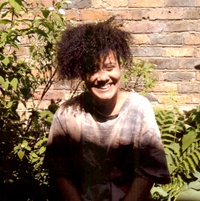On the meditative power of drawing
Prelude
Wendy Hollender is a botanical artist, illustrator, author, and instructor. Her illustrations have been widely published and her work has been included in the 13th International Exhibition at Hunt Institute for Botanical Documentation and in exhibitions at the Royal Botanical Gardens, Kew, and the Smithsonian National Museum for Natural History. She is the author of several books, including Botanical Drawing in Color and Botanical Drawing, A Beginners Guide. She is an instructor of Botanical Art and Illustration at the New York Botanical Garden and leads workshops at her farm in Accord, NY, as well as in locations such as Trinidad, Hawaii and many nature preserves, botanical gardens, arts centers and colleges around the world. Her new book, The Joy of Botanical Drawing: A Step-by-Step Guide to Drawing and Painting Flowers, Leaves, Fruit, and More, was published in April 2020.
Conversation
On the meditative power of drawing
Botanical illustrator Wendy Hollender on what it means to really look at something, how a creative practice can serve as a kind of calming meditation, and how drawing plants can function as an entry point into the natural world.
As told to T. Cole Rachel, 3142 words.
Tags: Art, Inspiration, Process, Beginnings, Success, Mental health, Education.
Were you always drawn to botanical illustration, or were you an illustrator that discovered that this is what you were good at? How did this become your thing?
Back when I went to college and studied art, I first became a home furnishing textile designer. I was very good with color and pattern, but I could not draw realistically at all. When I went to college, which was a long time ago, they were resistant in teaching you how to draw realistically. I went to Rhode Island School of Design and it was full of incredibly talented people, many of whom already knew how to draw because they always did it their whole lives, but that wasn’t me. They taught you how to think creatively, but not to give you the necessary realistic tools.
Eventually I became a home furnishing designer because I loved to cover surfaces with patterns. At a certain point I became fascinated with old botanical prints and how realistic and beautiful they were. I could copy a flat print, but I couldn’t draw from real flowers and nature. Still, I loved being outside with nature, and I was inspired early by my mom’s gardens and wanted to draw her flowers.
At some point a light bulb went off and I realized that all these botanical illustrators must’ve learned this technique somewhere and maybe I could learn, too. I discovered a program—I guess this was 22 years ago—at the New York Botanical Garden. I went to study there and it literally changed my path and my life right away. I said, “Oh, this is what I needed to know how to do, how to use one light source, how to understand perspective.” Plants were a great subject because, unlike people, the plants were cooperative and actually stood still. You could take the time to learn one little concept at a time.
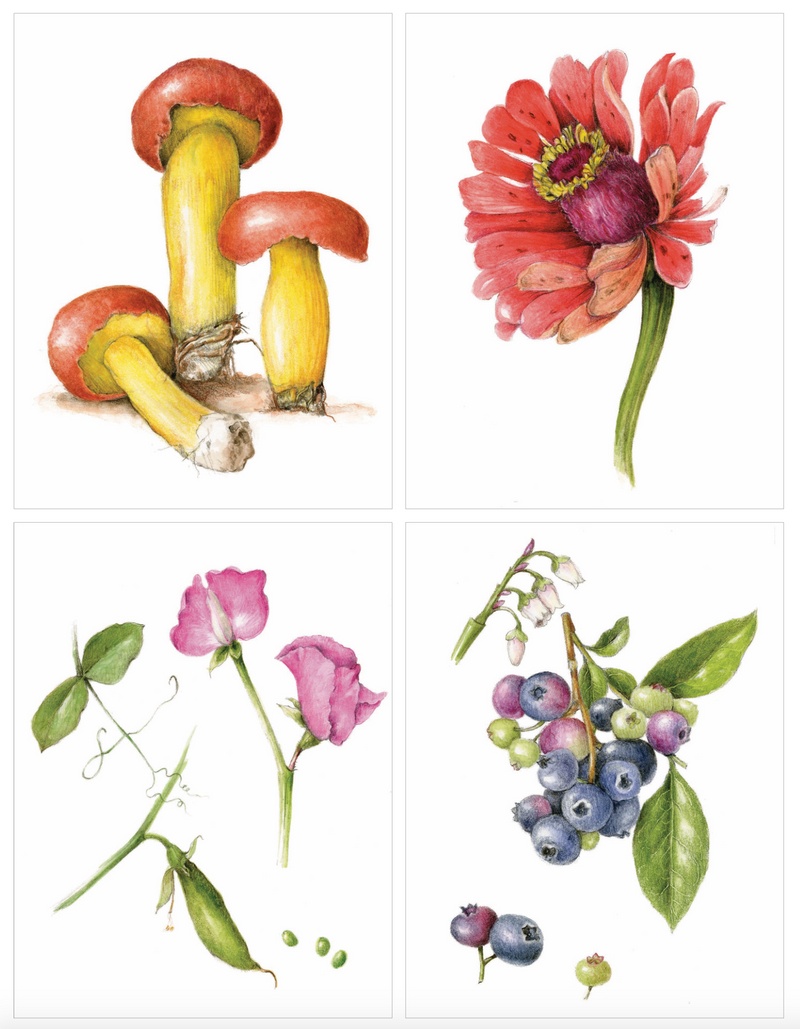
from The Joy of Botanical Drawing: A Step-by-Step Guide to Drawing and Painting Flowers, Leaves, Fruit, and More
So that’s what happened for me. I have just literally followed along the path since that day, and part of that path was being so grateful for all the instructors I had in botanical illustration who were willing to share the secrets and the techniques with me. When I was still really early on in my studying at the botanical garden, they asked me to teach in their programs. I think in part because I started using colored pencil in a way that was a developing technique at the time. It used to be only watercolor for botanical illustration and, at the time, colored pencil was just beginning. I got really into it, and because the materials were so portable, I could take it with me and draw when I would go on location for work. I started teaching there and developing more of my own process for how to do it and also how to teach it because I wanted to give back at the same time.
During that time were you also being called upon to do illustrations for other people?
Yeah, right away. The first thing I did in my home furnishing textile design was put my new botanical skills to work. I started doing a line of very botanical detailed designs for dinnerware and bedding and different kinds of home furnishing fabric. I did that right away, but then I became even more and more drawn to just the botanical illustration, so I started to launch myself in that direction. I started to get some commissions to do work for a calendar for the Riverside Park Conservancy, which was one of my earliest clients. From there I just kind of built on it and got more and more work.
And now you split your time between several places, right? You still work for the New York Botanical Gardens, but you also teach at other places?
Yeah. About 10 years ago I moved out of Manhattan to the Hudson Valley because I really felt the need to live with the plants full time, not just go away for work and then come back to New York City. So I got a four acre piece of land that I developed with the help of my kids, who were both interested in farming and permaculture. We created gardens and a place for me to work. I converted an old horse barn into my studio and I moved up from Manhattan and relocated my whole business there.
I have a lot of inspiration right there on the farm to draw from, and my son is also a full-time farmer right in the area and he grows all kinds of stuff that I get to use. I started workshops on the farm so people can come and get the full experience of the immersion in botanical drawing, then we cook them lunch from what’s growing on the farm so you can really experience everything. I teach there and I do illustration work there, and then I go to the New York Botanical Garden a couple of times a year to teach. I do workshops all over the world. I think it’s important for everybody, whether you become a botanical artist or not, to get to experience plants in so many ways, and botanical drawing is a really nice way to get into that world.
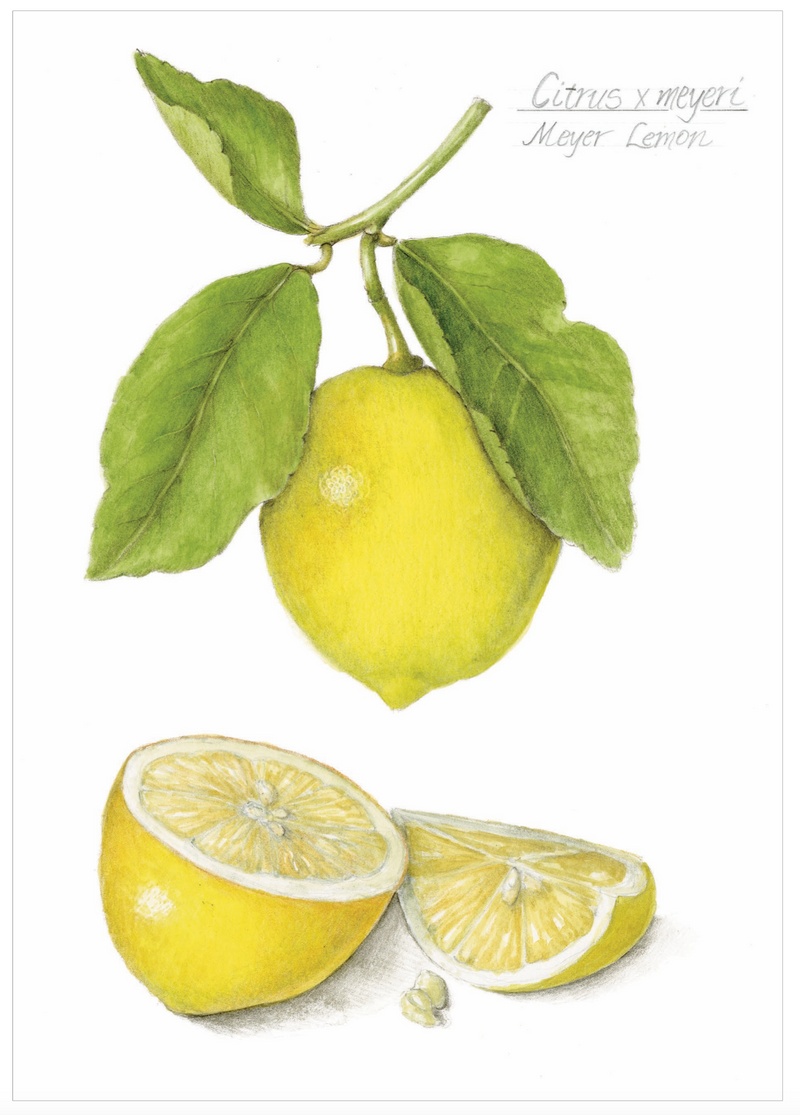
from The Joy of Botanical Drawing: A Step-by-Step Guide to Drawing and Painting Flowers, Leaves, Fruit, and More
One of the things I loved the most about your book, The Joy of Botanical Drawing, are the things you say in the beginning about doing this kind of work—looking closely at plants and drawing them—as a kind of mindfulness or a form of meditation. I was just thinking how rare it is for most people nowadays to have any occasion during the regular workday where they stop and really look at something. You think you know what a flower looks like, but until you try and replicate it, you don’t realize how little about it you’ve actually paid attention to.
It’s very, very powerful. It’s a total meditation, but literally it’s almost like the plant and you become one. I know that sounds a little cliché, but I feel that—that my hand is doing the drawing, but the plant is dictating it and helping me. I’m getting to go inside that world, almost like an insect does, and experience the plant. It’s very powerful. If I’m having a rough day it’s like, “Just go and draw for an hour. You know you’ll feel better,” and I do.
Sometimes I use it as a way of just slowing down and connecting and meditating. I see how it works on the people who come to my programs or take my online program, or whatever. I can literally see how it affects peoples’ lives—the way it calms them—and it feels great to be able to do that. I wish I could do it for more people, not only those who have the time to study botanical illustration, but people who just need a half hour or an hour a day to stop looking at a screen, for example.
**In the book you mention how a lot of people approach drawing with trepidation because there is that feeling of “I’m afraid that I’m doing this wrong. I don’t know how to do this.” It’s interesting—and sad, honestly—how people have been made to feel separate from these kinds of processes, or that creativity is inaccessible to them. **
Yes. It’s kind of a sad state of affairs that people are not allowed to have a hobby anymore, something that they do just for the pleasure of it. It shouldn’t matter if you are any good at it or not. It should just be that you want to do it and enjoy it and learn from it and try something and see where it takes you. We often don’t allow ourselves that option. We think we have to be masters before we even begin.
Over the years I’ve learned this more and more, so I start teaching people with that in mind. I know you’re afraid of this and you don’t want to ruin your paper and you might be a perfectionist and all that, so I just say, “Please allow yourself to quiet the voice that tells you that you can’t do this. Tell that voice you’re not listening to them right now, because that voice stops you and I don’t want to stop you. I want to give you the opportunity to try.”
I hope to show people that the slow act of repetitive drawing is like a meditation and it quiets that negative voice. I invite them into that kind of free creative space, and it really helps because everybody has those voices inside of them and it’s not a helpful voice.
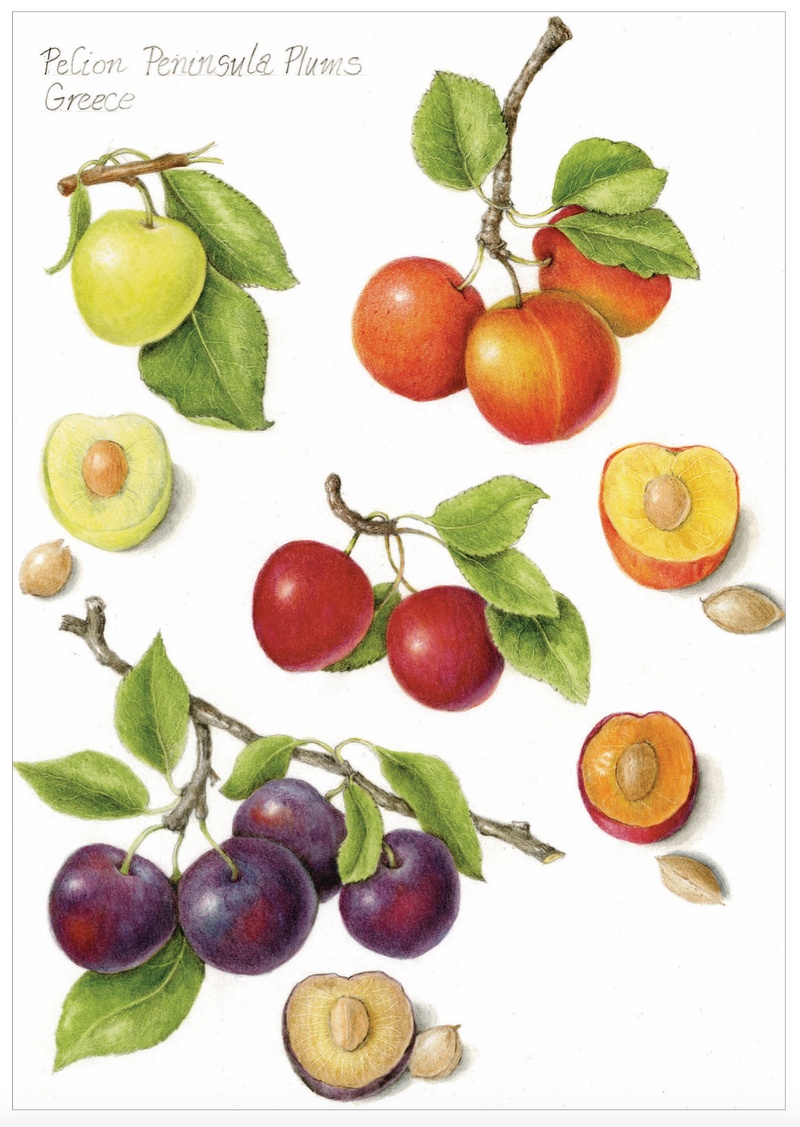
from The Joy of Botanical Drawing: A Step-by-Step Guide to Drawing and Painting Flowers, Leaves, Fruit, and More
Your new book is a beautiful art object, filled with illustrations, and it’s also instructional, featuring how-to drawings and in-progress illustrations showing people how these kinds of drawings evolve as you do them. Making a book that teaches people how to draw seems like a pretty complicated task.
I didn’t want to intimidate. I wanted to invite people in and do it in such a way where it wasn’t overwhelming. A lot of botanical programs are very complex and very detailed and hard to do because it’s such an involved process, and I didn’t want it to be that way. Many people who engage with the discipline of botanical illustration at a high level, they put on white gloves when they get down to their drawing table so that everything is perfect and doesn’t get messed up. They can work for months on a painting, after the plant itself is long gone. For me, I wanted to keep the process alive and in the moment, because what I care about is that interaction between you and the plant and what happens there. I don’t really care about a finished piece necessarily.
I want to bring you in and allow you to feel like, “Oh, I could try this,” and for you to enjoy it, and then whatever happens happens. That was my goal with the book—to keep the exercises bite-sized and like a recipe in a cookbook. That was what I hoped to do. Thankfully my publisher loved it and I worked closely with a team of editors and a graphic design team to get the message across. I didn’t want to use photographs in the book, just because I wanted it to feel more organic and I love the colors and the pencils and all of that stuff. So it’s like, “Oh, I have to do all of these little drawings.” Nobody said I should do them, I just had to do them.
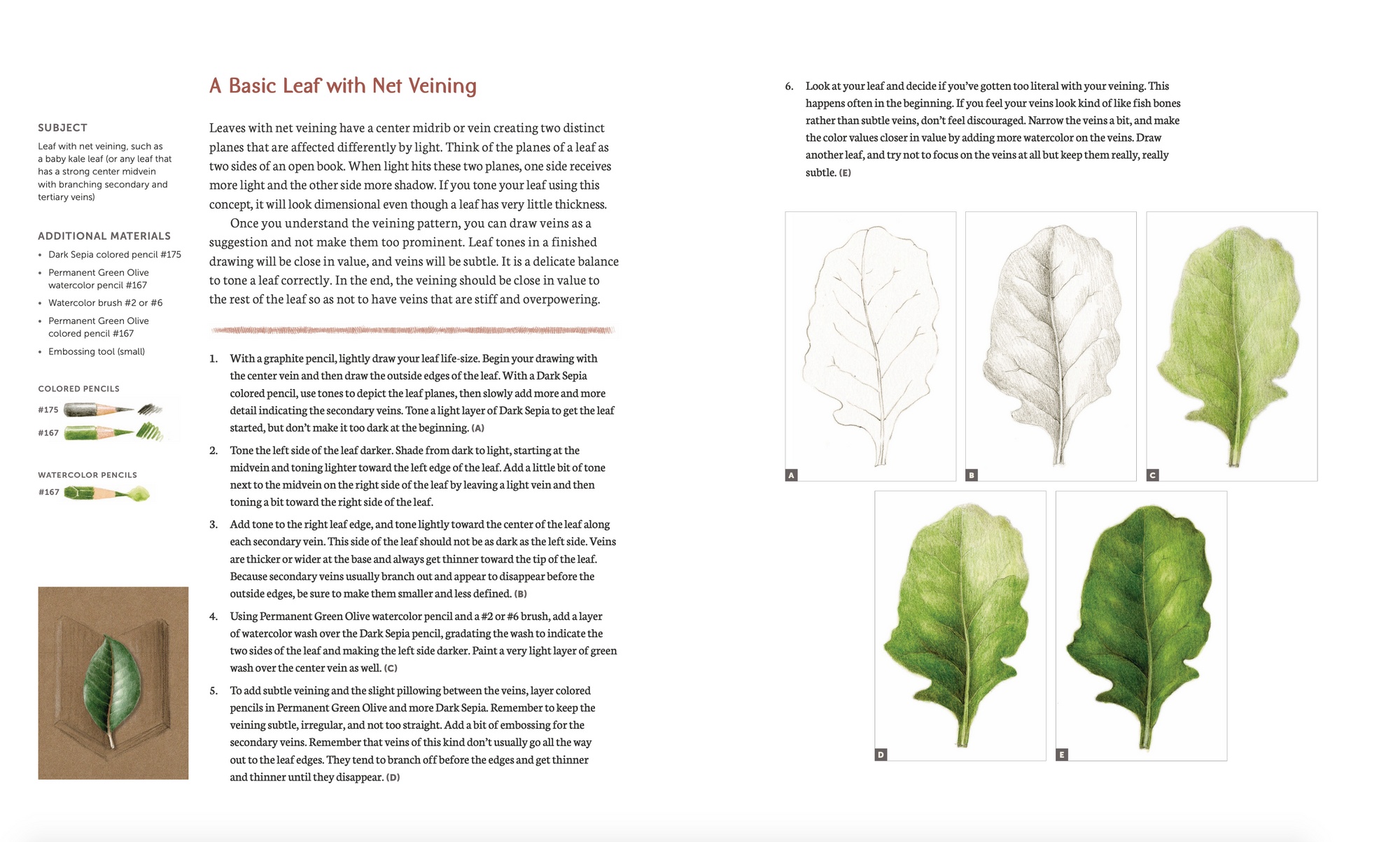
from The Joy of Botanical Drawing: A Step-by-Step Guide to Drawing and Painting Flowers, Leaves, Fruit, and More
How important is it to be able to work from a live reference, as opposed to a photograph?
With my experience now I can work from photographs, but photographs actually lose a lot of information and they make you forget certain things, like structure and the three-dimensional quality and how things are attached. I will use a photograph as a tool to help me sometimes, but I always work from a real plant. The only time I don’t is if I’m doing a commercial illustration and there’s a deadline and you can’t get the actual plant in front of you—maybe something’s not blooming at that time of year or it doesn’t grow where you are. For example, cacao doesn’t grow in New York, but by now I’ve done so many drawings and studies and I have a lot of similar plants that I can look at as well. Still, I always try to work from the real plant because I do believe that the real thing helps you. Also, I just enjoy it 10 times more, so why wouldn’t I?
I like that your book breaks down the materials that you would need to do this type of drawing in an easy way. For someone like me, for example, who is living in a small New York City apartment, it’s great that you don’t really need a lot of stuff to do this kind of drawing. It’s not super complicated in that way.
Right. It’s not complicated. It’s all nontoxic. It travels well. You can set yourself up at your kitchen table. For example, I love working in my kitchen. Even though I have workstations in my big studio loft set up, sometimes I just want to be in the kitchen with that radish or piece of fruit that I’m drawing. I have always had my “to go” bag ready and it just goes with me. It’s pretty easy to just open and get started pretty much anywhere, and that helps to make it easy to do, too. It’s not a whole big thing you have to set up and then clean up.
It’s so nice to have a creative practice that keeps you so symbiotically connected to the natural world. So much of the time I’m talking to artists who are all about working on a computer and infusing technology into their work.
I can do my work digitally if I want to and I’m pretty used to using a lot of the programs and tools. A few years back, when the Apple Pencil came out, I said, “Oh, I’m going to get that and I’m going to do that,” and I have it and I can use it, but it doesn’t suit me. With a computer, you don’t have that same friction created when your hand, your pencil or your brush moves along a piece of paper. I just love that. It’s a very different feeling. So I use technology after I do my images, but I don’t use them to create my images, because it feels much better to me. To me it’s kind of like, you can either eat a delicious fresh-picked farm-to-table dinner with vegetables that just came out of the ground, versus opening a box and a package and putting it in your microwave. It’s your choice, which tastes better?
Do you ever draw people?
Sometimes. I’m not great with people. I’ve been working for years on this kid’s book, which is close to being ready, and I draw pollinators and sometimes little animals. So in my kid’s book, it’s a story of a mouse in my garden and me as the botanical illustrator. So I have me in it everywhere drawing, and the mouse is everywhere with the vegetables. So I do that. I sometimes get hired to do cheese illustrations or, recently, to draw oysters. So I will do a little bit here and there, but I’m pretty much all about the plants.
It feels great to have gotten good at one thing. I love that part of it. Also, do you know how many plants there are to choose from? I just haven’t even scratched the surface of that world, so I’m never bored. With plants, there’s something inside of me that just sees it and I want to draw it, whether it’s a dried seed pod I pick up on the ground, or a new kind of radish here on the farm that my son has grown and happens to be really beautiful. He’ll find one for me and just say, “Check this one out, mom.” My daughter makes natural dyes with plants, so she’ll say, “Mom, this sunflower makes the best yellow dye,” and then I’m like, “Oh! I need to draw it.”
I like the story behind the plants as well, and that compels me to want to get to know them and to draw them. I’m very interested in just continuing to illustrate plants, especially those that people don’t know much about. When I did illustrations for a foraging cookbook, I was drawing a lot of weeds, a lot of them invasive plants that are just awesome in terms of how they grow. It’s amazing how they learn to survive, but they’re also delicious to eat and they’re nutritious and they’re just there for the taking. I’m all about showing that.
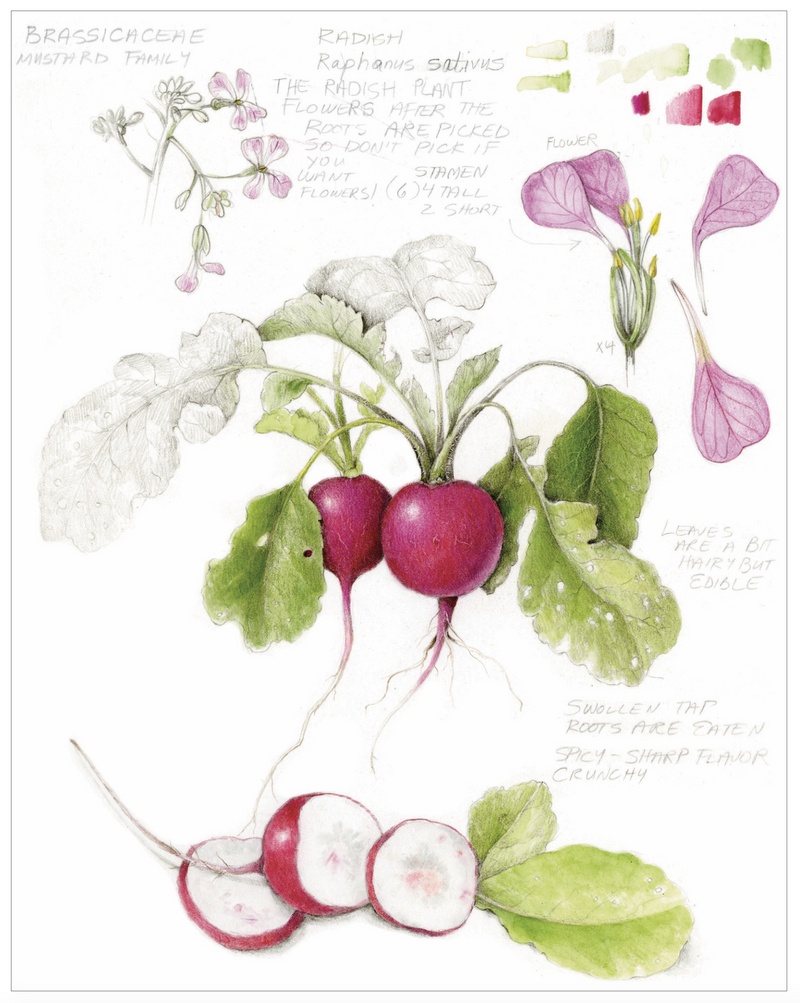
from The Joy of Botanical Drawing: A Step-by-Step Guide to Drawing and Painting Flowers, Leaves, Fruit, and More
Wendy Hollender Recommends:
When people are just starting to learn how to draw, I tell them to think of it as a kind of daily meditation, which is what I do. If I need a way of slowing down, I just practice very slow toning, drawing and shading from dark to light—getting into the relaxing, repetitive motion of stroking your pencil slowly in one direction and then in another direction and building up your layers. Once you feel good about that, I suggest just picking one simple, small, round, juicy subject—such as a cherry tomato or a small citrus fruit or a nut—and study that one thing closely. Try to use your slow toning to draw it as if you could pick it up off the page. Make it as three-dimensional as you can. Keep practicing.
By the same token, pick up any one thing, whether it’s one leaf or a petal off of a flower. Maybe start with a beautiful colored petal, because a whole flower is pretty complicated. Start with one petal, start with one leaf, and just look at it closely. Really undress it and take it apart and use a magnifier and study the reproductive parts, and then do a little research on what it is and where it comes from and how it grows. Learn what the parts are and how they are used. Looking really closely and deeply at a small thing can totally change your perspective.
Right now I’m looking outside at some leaves on a tree that are changing color and it reminds me of how in the fall everybody back East wants to experience fall color. If you pick up one beautiful colored leaf and you study that and then you take some colored pencils and try to match the different color variations, you get to go inside that beautiful fall color and it will delight you.
- Name
- Wendy Hollender
- Vocation
- Artist, Teacher
Some Things
Pagination
